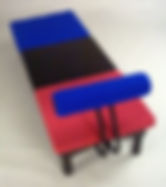Musical Perception
People with hearing loss are able to perceive some of the sound of music. However, when using hearing aids or cochlear implants, their perception of musical sounds differs individually, and the ways of expressing musicality might differ from people with normal hearing. For example, a normal ear has a frequency range of 20Hz (low sounds) to 20,000Hz (high sounds) and can detect fractional differences in pitch, giving a complete and intricate experience, especially when it comes to music. Whereas a CI user can only differentiate much larger jumps in pitch, more like every 80Hz. This makes it hard to separate different notes and pitches, and the difference between major and minor chords. It’s impossible to know a male voice from a female voice, melodies become monotonic, and sounds are robotic and coarse. Learning to play an instrument or to sing might be challenging and require different techniques, but it won’t be impossible. As an example, you can read more about Russ' own musical journey with hearing loss here.

Feeling the Music - Vibroacoustic Therapy
Those with hearing loss can feel the vibrations created by music through their bodies. As we know, everybody can feel the very loud bass drum in a rock concert. This is called 'Feeling the Music' approach. In scientific terms this is defined as a vibrosensoric experience.
In music therapy the feeling of vibration through our bodies is sometimes not fully appreciated. Vibroacoustic therapy could provide a means to explore music through feeling the vibrations.
Vibroacoustic therapy started in Norway in the early 1980s by Olav Skille. Afterwards the techniques expanded to the UK by Tony Wigram and to Finland by Petri Lehikoinen. See also Skille-Lehikoinen centre of vibroacoustic therapy in Finland.
The Application of Vibroacoustic Therapy within the Music Therapy Profession
by Russ Palmer, SRAT (M), Vibroacoustic Practitioner ISE Research Group, University of Helsinki, Finland
Vibroacoustic therapy started in Norway in early 1980s by Olav Skille.

Afterwards the techniques expanded to the UK with Tony Wigram during the 1980s, and Finland with Petri Lehikoinen in the 1990s. Olav Skille also worked on updated versions in the 2010s.



Treatment Applications
Vibroacoustic Therapy could help those with:
-
Cerebral Palsy
-
Physical or muscular injuries with pain management
-
Alzheimer's disease and dementia
-
Parkinson's disease and complex syndromes
-
Drugs and alcohol abuse
-
Mental health issues
-
Multiple and complex disabilities
-
Sensory impairments
Frequency range 40 - 80Hz Low tones below hearing threshold
Additional Vibroacoustic Facilities 1980s/90s
These facilities are mainly used with pre-recorded music connected to an amplifier (25-50W), CD player or laptop computer, and include from left to right, the Fixed Music Floor in Norway, the Water Bed in Denmark, and the Resonance Box used for children in Finland.



In addition, there is the TacTile Sound System TM (TTSS), developed in 1994 within the Art & Design Research Centre at Sheffield Hallam University. Product development has been undertaken by Russ Palmer, Paul Chamberlain (Principal Lecturer Industrial Design) and David Mitchell (Researcher) in collaboration with the "Snoezelen Project" at Walton Hospital (North Derbyshire – NHS Trust).
The aim was to produce a ’modular designed’ portable music floor which could be adapted to meet the demands of professionals working at residential centres, hospitals and out in the field.



The TTSS is a therapeutic system, which delivers sound to a series of resonating surfaces where they are converted into mechanical vibrations, which can be felt by people who cannot hear sounds in the usual way. Various sound sources can be fed into the TTSS, and users make contact with the resonating surfaces by lying, sitting or standing on the units. The vibrations are ‘picked up’ wherever parts of the body make contact with the surfaces, and different parts of the body react differently to higher or lower frequencies.
Sound through vibration has been observed to affect both the mood and behaviours of deaf users in ways, which mirror the effects of music on hearing people.
For further information on Vibroacoustic conferences and courses, please visit:
Meet Orla O'Sullivan
Orla is a deafblind musician who is a concert level pianist and a qualified music teacher. She lives in County Cork, Ireland. Orla and Russ have worked together in the past giving a talk entitled “Two Musical Journeys”at the Sense Annual Lecture in November 2012. Orla has developed a musical device for hearing impaired students who wish to experience music.
For more information, please visit:

Articles & Resources
By Russ Palmer, Olav Skille, Dr Riitta Lahtinen and Dr Stina Ojala - 2017
Feeling and experiencing the vibrations produced by music helps to understand what the concept of music is. Music and vibroacoustic therapies have overlapping effects; music is for listening while vibroacoustic therapy is similar to physiotherapy.
By Russ Palmer and Dr Stina Ojala - 2016
The concept of feeling vibrations using different vibroacoustic technologies...
enabling people to experience low tone frequencies for different kinds of relaxation
techniques... later used in the areas of music therapy.
By Russ Palmer, Dr Stina Ojala, Heikki T Tuominen and Ilmo Korhonen - 2014
The primary scope of this study is in finding purely acoustical ways of supporting performers of
acoustical music and speech.
By Russ Palmer, Dr Stina Ojala, Dr Ritta Lahtinen - 2012
In this article we introduce a systematic, holistic way of experiencing music performances through touch.
By Russ Palmer and Dr Stina Ojala - 2012
Music consists of different textural elements such as rhythm, pitch, and melody. These elements can be illustrated through touch during an interactive process between two people.